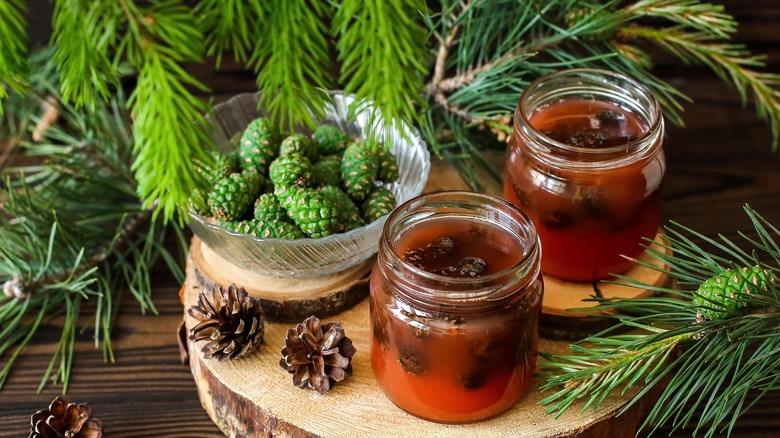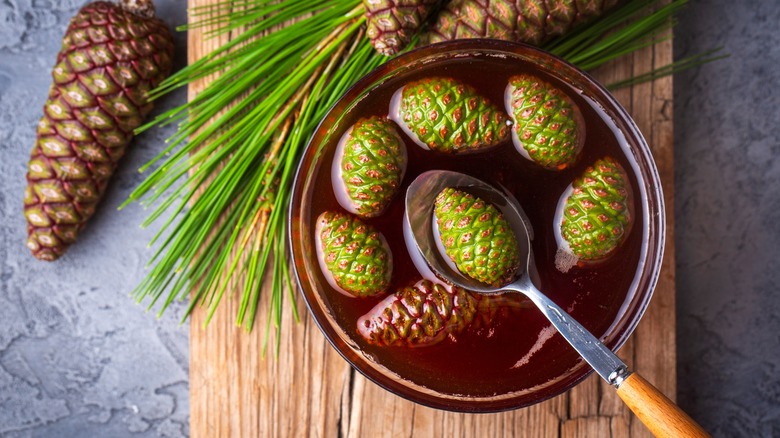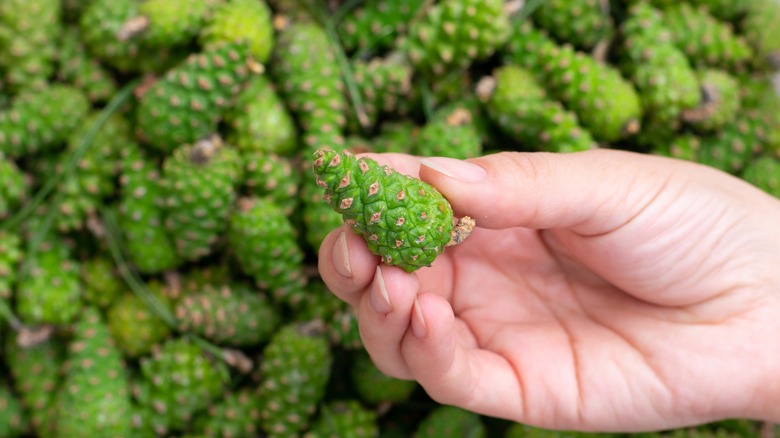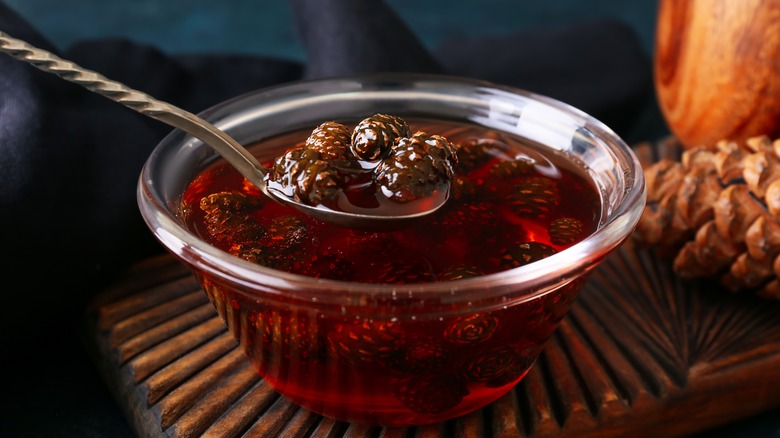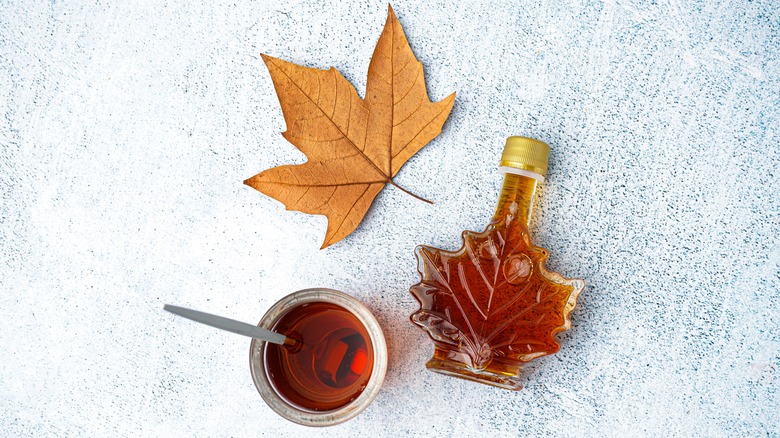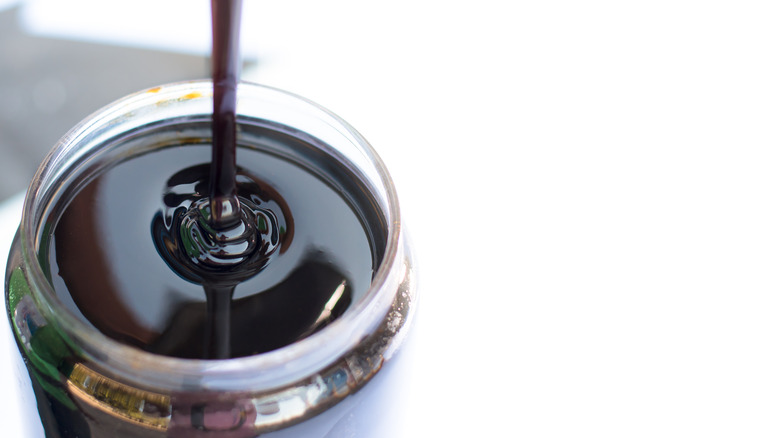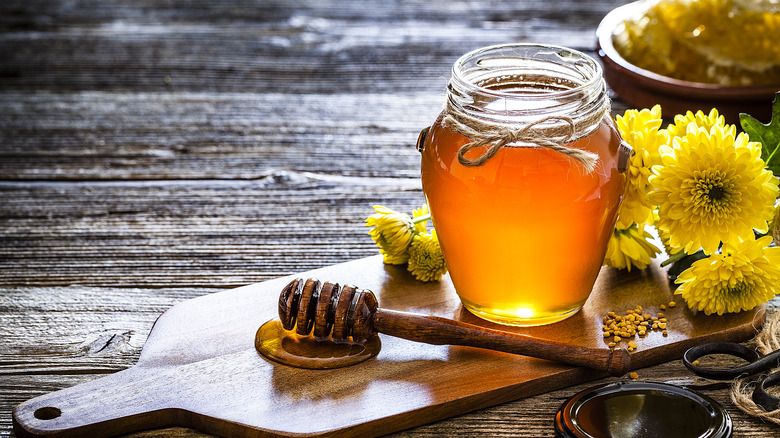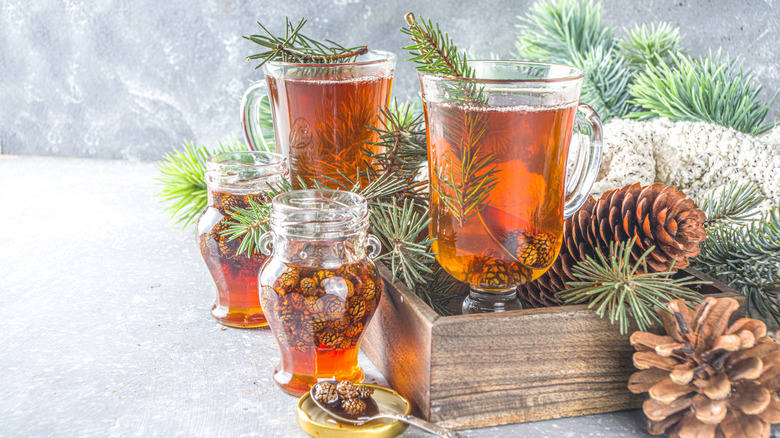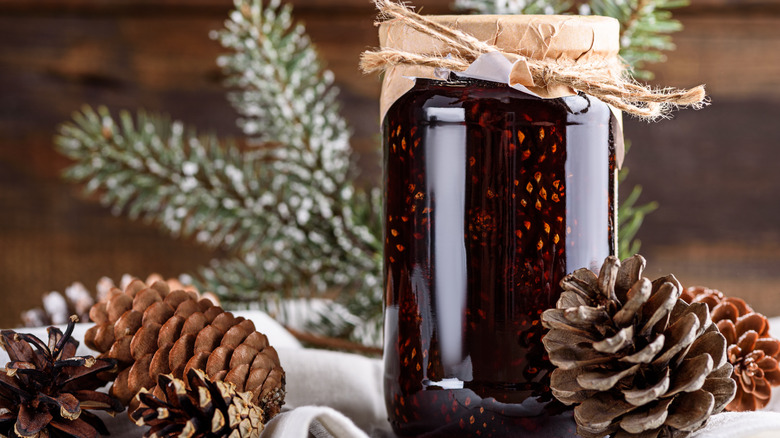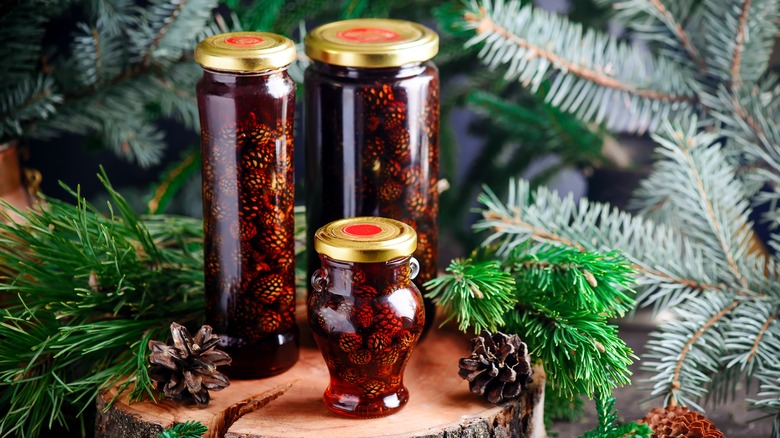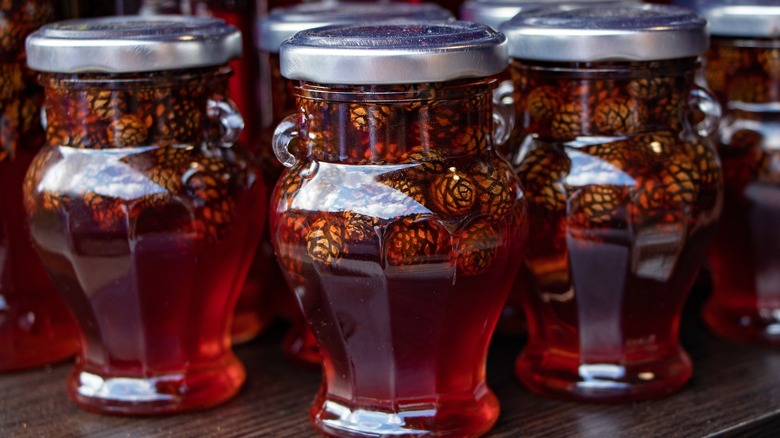What Is Pine Cone Jam And What Does It Taste Like?
Nowadays, more people are cooking at home, and there is a greater interest in understanding where food comes from. Some are even trying their hand at growing their own food and home canning. This resurgence in home cooking and food preparation has led to another traditional pastime, food foraging. Food foraging is spending time in nature exploring and looking for edible wild plants and fungi. Foraging for food is nothing new; our ancestors were foragers, and their lives literally depended on it. But today, food foraging is more of a hobby for nature lovers and creative home cooks rather than a necessity.
When you step into the forest, you might be surprised how many different wild foods you can find; from wild mushrooms to brightly colored berries to fresh herbs and velvety flower petals, the natural world has a lot to offer a hungry forager. While you may be familiar with some wild foods, there is one that may surprise you: pinecones. It may be hard to believe that those prickly-looking hard cones are actually edible, but they are, and experienced food foragers have been using them to make a syrupy, sweet condiment called pine cone jam for generations. If you have never heard of pine cone jam before, let's look at what it is and what it tastes like so you can decide for yourself if it's worth a walk in the woods.
What is pine cone jam?
Pine cone jam is a syrup made from small green pine cones. It is sometimes referred to as pine cone syrup or pine cone honey, but they are all just variations of the same thing: A thick, simple syrup made from young pine cones and sugar. When the pine cones are cooked down, they release a resin that has a strong pine scent and acts as a pectin, transforming the texture of the syrup. The sugar tones down the piney intensity and makes it sweet.
Pine cone jam has its roots in Eastern European cuisine, specifically Russian and Georgian cuisine. This part of the world is known for its abundant thick forest lands, where locals forage for wild mushrooms, stinging nettles, savory herbs, and even the coveted king of foraged foods, truffles. This thick syrup is used to sweeten hot tea and as a home remedy for a sore throat. It's also popular to drizzle it on sweet bread and blinis, which are traditional little Russian pancakes.
In Russia, pine cone jam is called varenye, which is a cooking method similar to making jam or preserves by boiling fruit with sugar until it reduces. Pine cone jam is just one of the many varenye's made in the region from foraged treats.
How is pine cone jam made?
Making pine cone jam starts with the key ingredient, pine cones. But not any pine cones will do. The larger pine cones that are easy to find all over the forest floor are great for kids' art projects and holiday decor, but those aren't the ones used in making pine cone jam. Instead, you will need to look for small green pine cones from an inch to a few inches in size. These young pine cones will be soft and sticky with resin when you squeeze them.
The best time to find them is in late Spring to early summer. Pinecones from pine, fir, or spruce trees will work for making pine cone jam. The type of pine cones used will alter the syrup and give each one a distinct flavor.
The actual process of making the jam is simple once you have the right size pine cones. You mix them with water and sugar and bring them to a boil. Simmer until the syrup has reached the desired consistency and flavor. Then, transfer it to a large jar and let it cool before storing it.
In Italy, pine cones are used to make Italian mugolio. Mugolio is similar to pine cone jam but fermented and only boiled after fermentation. Mugolio is often added to cocktails and is considered a delicacy.
What does pine cone jam taste like?
Pine cone jam is sweet with an earthy, almost tart taste. However, the taste can vary depending on the size and maturity of the pine cones, the amount of sugar, and the cooking time. Pine cone jam on its own without sugar has a deep, almost medicinal pine taste, which is unpleasant to most people. The sugar is what makes the syrup palatable.
Traditionally, the syrup is made with raw sugar like turbinado or brown sugar. These darker sugars help give pine cone jam not only its sweet taste but also darker color. But white sugar works fine as a substitute. Some food foragers add citric acid to their pine cone jam for a citrusy or sourness that complements the sweetness. Apple cider vinegar is another add-in that can add more depth of flavor and cut the intensity of the pine taste. There are no hard rules when it comes to making pine cone jam, and the measurements and ingredients can vary to different tastes.
Pine cone jam versus maple syrup
Pine cone jam is similar to maple syrup in a few ways. First, they both come from trees. Maple syrup comes from the sticky sap of maple trees, and pine cone jam from the pine cones of pine, fir, or spruce trees. They are similar in taste and consistency. Both have a robust and sweet flavor, but maple syrup is slightly sweeter than pine cone jam and has no strong pine scent. Due to their similarity, you could use both syrups interchangeably in some dishes. For example, both can be drizzled over pancakes or toast, but maple syrup is too thick to work in tea or coffee.
Making maple syrup from maple tree sap is similar to making pine cone jam from resinous pinecones. To make maple syrup, the sap, which is more watery than resin, is boiled down until the water evaporates and reaches the desired consistency and sweetness. While pine cone jam is made by boiling the pine cones in sugar water. Pine cone jam needs water to dilute the thick resin into a syrup, while sap needs the water removed to finish processing.
Unfortunately, there are a lot of maple syrup imposters on supermarket shelves, which are filled with sugar and additives. So, if you are looking for real maple syrup to taste test both syrups, make sure to read the labels.
Pine cone jam versus molasses
Pine cone jam has more differences than similarities with molasses. Molasses is a thick, sticky syrup that is a by-product of the sugar refining process. Depending on how many times the sugar is boiled down, you get different colors of molasses, from light to dark to black. The taste gets stronger with each color. And the darkest molasses, called blackstrap molasses, is quite bitter. Compared to pine cone jam, molasses is thicker and isn't as sweet as pine cone jam.
The three types of molasses are used for different things; the lightest is often used as a sugar substitute in baking, while the darker is better in marinades and glazes, and blackstrap molasses is prized for its health benefits, as described on Healthline. Pine cone jam most closely resembles light molasses. But pine cone jam has its own unique flavor, and it would be tricky to substitute it in a sweet recipe like gingersnap cookies. While you can't substitute one for the other, you could replace a portion of molasses with pine cone jam for a deeper flavor.
Pine cone jam versus honey
Pine cone jam is more like honey than molasses or maple syrup. Both honey and pine cone jam can vary in color and intensity and have a delicate, sweet taste. Both are excellent in hot tea and can help coat and soothe a sore throat. You can also use them interchangeably when cooking. For example, both are good in sweets and baked goods and work in savory dishes and condiments like glazes, marinades, and barbecue sauces.
Despite their similarity in taste, pine cone jam and honey couldn't be more different in how they are produced. Bees make honey by collecting flower nectar, which turns into honey in the honeycomb. The honey is then used in the hive for food and other practical uses. Whether humans collect the excess honey or not, bees make honey. In contrast, pine cone jam is not a natural occurrence, and if nobody is out there foraging young pine cones and boiling them with sugar, there is no pine cone jam.
How to use pine cone jam
Pine cone jam is a versatile syrup used in sweet or savory dishes. While commonly used in hot tea, it has so many other uses you will be glad to have some in your cupboard. It is an exciting addition to a charcuterie board where the sweet, potent taste pairs perfectly with salty prosciutto and spicy salami. It also complements rich, creamy, soft cheeses like brie. You could drizzle it on a baked brie for a flavor and texture contrast. Or add it to toast or pancakes for a decadent breakfast. For those who really have a sweet tooth, adding pine cone jam to whipped cream or ice cream can turn something basic into something special.
This amber syrup doesn't just work with sweet flavors; it can lean savory, too. You can add it to your favorite roasted vegetables to aid in the caramelization. Or turn it into a glaze for chicken, pork, or even tofu. Mixing it into a vinaigrette or marinade is a great idea, too. And since pine cone jam is essentially a simple syrup, you could add it to festive holiday cocktails or mocktails for a unique taste and a fun conversation starter.
Where to buy pine cone jam
If the thought of foraging pine cones, cooking them down, and cleaning all the sugar and resin from your favorite pots and pans isn't appealing, you will be pleased to learn you can purchase pine cone jam. Although you won't find pine cone jam on the shelves of your local supermarket, you can find it in your local international markets or stores that cater to Eastern European cuisine. You can also find it online.
Wherever you decide to purchase pine cone jam, you should always read the label. Authentic pine cone jam has four ingredients: Young pine cones, water, sugar, and some acidic components like lemon juice, citric acid, or vinegar. Most store-bought jars of pine cone jam have little pine cones floating in the thick syrup, and some even have pine nuts for added flavor. And those small pine cones aren't just decorative; they are edible with a soft, chewy texture. They make cute edible decorations on pastries. Commercially prepared pine cone jam, like most store-bought foraged foods, can be expensive.
Nutritional information on pine cone jam
Since pine cone jam is foraged and the amount of sugar and pine cones varies, it is challenging to know the exact nutritional value of homemade pine cone jam. Small-batch commercial varieties often include nutritional information, but it's usually in Russian, depending on the manufacturer. Based on the nutritional information of Samsonov Pine Cone Jam, a serving of two tablespoons has 74 calories and 19 grams of carbohydrates with an additional 13 grams of added sugars. Compared to maple syrup, molasses, and organic honey, pine cone jam is lower in calories and sugar.
While sugary pine cone jam doesn't offer much nutritional value, it has been connected to medicinal properties. In Russia and Eastern Europe, it is a common folk remedy for anything from sore throat to cough, as claimed by Visit Novgorod, to digestive issues, according to Aroma Chai Tea, to fatigue and seasonal depression, as stated by Garden Lux. It's considered an immune booster and thought to increase vitality and overall health. While it's true that pine cones are covered in resin, which has anti-bacterial properties, and tannins that are anti-inflammatory, there aren't many scientific studies to back up these health claims. Like many folk remedies, the evidence is sometimes just anecdotal.
Some pine cone foragers forgo the jam altogether and instead make a medicinal tincture by soaking the pine cones in alcohol for several weeks. The resin breaks down in the alcohol, and the resulting tincture is taken as drops.
How to store pine cone jam
Pine cone jam can be stored similarly to honey, molasses, and maple syrup. You can keep it in the refrigerator or the pantry. Ideally, it should be stored in a glass jar where it won't get direct sunlight. Some foragers that make homemade pine cone jam also opt to can it by water bath canning. However, it is important to note that the National Center for Home Food Preservation does not have any information or recipes for pine cone jam. Although some of their jelly and jam recipes use honey instead of sugar, it is difficult to know the exact acidity of pine cone jam, making it possibly unsafe for home canning.
A bottle of pine cone jam left on a shelf may crystalize like honey. If that happens, just place the bottle in a bowl of warm water, and it should soften back up within an hour. Of course, once you try pine cone jam, you will probably start using it regularly, and it won't sit on the shelf long enough to crystalize.
